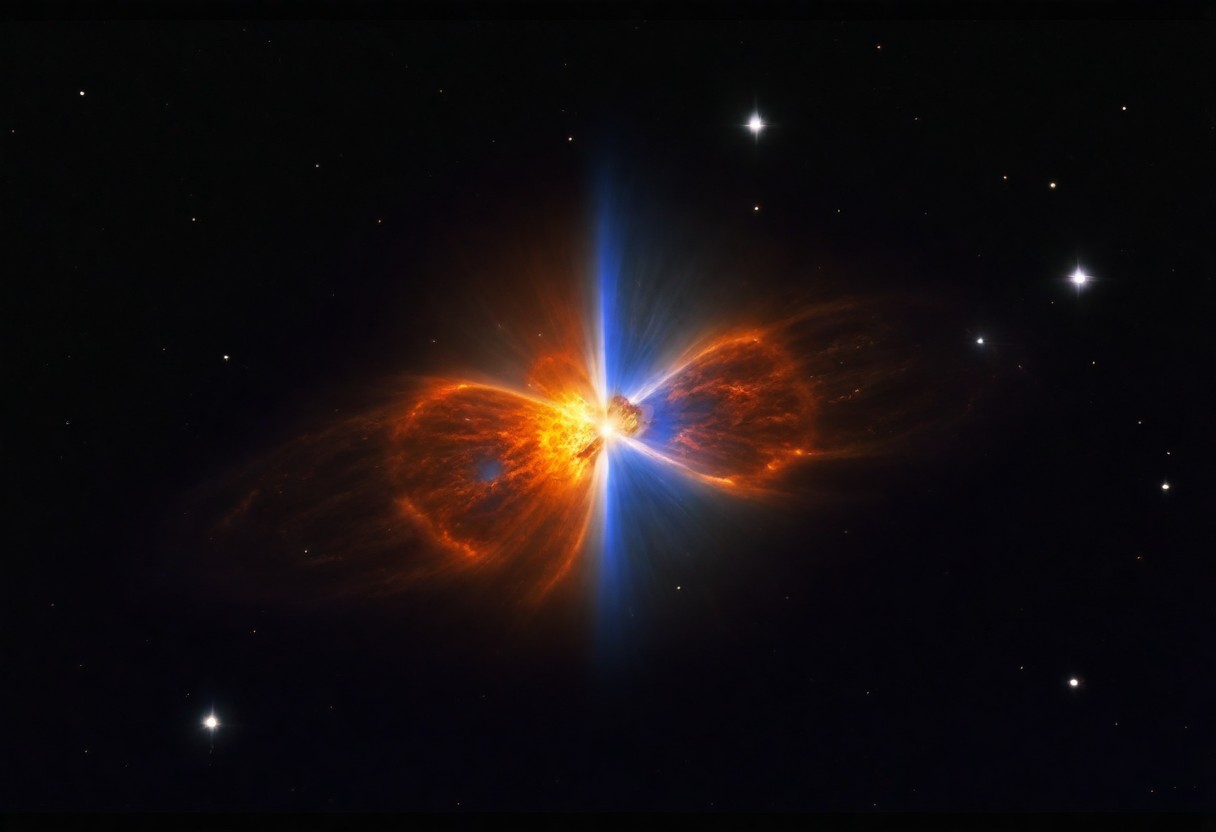In the grand tapestry of the cosmos, stars transcend their role as mere twinkling adornments in the night sky; they are the colossal engines of creation, the architects of a mesmerizing process known as stellar nucleosynthesis. This cosmic alchemy is the fundamental mechanism responsible for the formation of elements, from the simplest hydrogen to the complex structures that constitute life itself. To comprehend stellar nucleosynthesis is to peel back the layers of the universe, revealing the intricate processes that shape the very fabric of existence.
At the heart of this celestial symphony lies the phenomenon of nuclear fusion, where lighter elements meld together to form heavier ones, releasing prodigious amounts of energy in the process. Within the blazing cores of stars, the intense pressure and temperature provide the perfect crucible for this alchemical transformation to unfold. Hydrogen, the most abundant element in the cosmos, undergoes fusion reactions to produce helium, the initial step in the stellar fusion cycle known as hydrogen burning.
However, the journey of stellar nucleosynthesis extends far beyond the confines of hydrogen fusion. As stars evolve, they undergo successive stages of fusion, culminating in the synthesis of increasingly heavier elements. Helium fusion gives rise to carbon and oxygen, while successive fusion processes within the cores of massive stars lead to the formation of elements such as neon, magnesium, and silicon. These elements, forged in the fiery depths of stars, are scattered across the cosmos during stellar explosions and enrich the cosmic landscape.
Yet, the cosmic alchemy of stellar nucleosynthesis does not conclude with the formation of elements up to silicon. To create elements beyond this point, stars must undergo cataclysmic events such as supernova explosions or the collisions of neutron stars. In the intense heat and pressure generated by these cosmic upheavals, elements as heavy as iron and beyond are synthesized. This process, known as rapid neutron capture or the r-process, is responsible for the creation of precious metals like gold, silver, and platinum, as well as radioactive elements such as uranium and thorium.
The significance of stellar nucleosynthesis extends beyond the realms of astrophysics, permeating the very essence of existence. The elements forged within stars are the fundamental building blocks of planets, atmospheres, and living organisms. Every atom in our bodies, every breath we take, is a product of the cosmic processes that have unfolded over billions of years.
Moreover, the study of stellar nucleosynthesis provides profound insights into the origins of the universe and our place within it. By analyzing the chemical composition of stars, galaxies, and cosmic phenomena, astronomers can unravel the intricate history of cosmic evolution. The fingerprints of nucleosynthesis are imprinted on the cosmic canvas, waiting to be deciphered by the keen eyes of scientists.
Stellar nucleosynthesis represents the pinnacle of cosmic creativity, the transformative process that shapes the universe in all its diversity and splendor. From the birth of stars to the synthesis of heavy elements in stellar explosions, this cosmic alchemy weaves the intricate tapestry of the cosmos. To understand stellar nucleosynthesis is to unlock the secrets of the universe, revealing the fundamental processes that underpin the cosmos we inhabit.
The Birth of Stars:
In the vast expanse of the cosmos, stars emerge from the depths of interstellar space as luminous beacons of cosmic creation. Their origin lies within the dense, swirling clouds of gas and dust that pervade galaxies, containing the raw ingredients of stellar birth. These clouds, predominantly composed of hydrogen and helium—the primordial elements forged in the aftermath of the Big Bang—serve as the cradles from which stars are born.
The journey of stellar birth begins with the gravitational dance of these colossal clouds. Over eons, gravitational forces gradually draw together the dispersed gas and dust, causing them to coalesce into denser regions known as molecular clouds. Within these molecular clouds, the density and pressure continue to increase as gravity relentlessly pulls matter inward.
As the process of gravitational collapse progresses, these molecular clouds fragment into smaller clumps, each destined to become a new star. Within these clumps, the matter becomes increasingly concentrated, forming protostellar cores—the embryonic stages of stars. Here, at the heart of these protostars, conditions reach extreme levels of pressure and temperature.
It is within the core of these protostars that the transformative process of nuclear fusion ignites, heralding the beginning of a star’s lifecycle. The intense heat and pressure generated by gravitational collapse trigger nuclear reactions, primarily converting hydrogen nuclei into helium through a series of fusion processes. This phenomenon, known as hydrogen burning, unleashes immense amounts of energy, illuminating the nascent star and heralding its emergence into the cosmos.
The initiation of nuclear fusion marks a pivotal moment in the life of a star, distinguishing it from the surrounding darkness of space. As hydrogen atoms fuse together to form helium, a delicate balance is achieved within the star’s core. The outward pressure generated by the energy released from fusion counteracts the relentless force of gravity, preventing further collapse.
Thus, a star is born—a luminous sphere of incandescent gas, sustained by the ceaseless fusion reactions occurring within its core. From the chaotic turmoil of gravitational collapse arises a beacon of light and heat, destined to sculpt the cosmic landscape and shape the destiny of the universe.
The birth of stars is not merely a physical phenomenon; it is a cosmic ballet of gravitational forces, molecular chemistry, and nuclear fusion. It is a testament to the intricate interplay of cosmic processes that govern the formation and evolution of celestial bodies. As stars ignite across the vast expanse of space, they illuminate the universe and imbue it with the radiant energy that sustains life and fuels the eternal cycle of creation and destruction.
The Fusion Dance:
At the heart of stellar nucleosynthesis lies a cosmic dance of unimaginable energy and elegance: nuclear fusion. This fundamental process orchestrates the transformation of lighter elements into heavier ones, releasing prodigious amounts of energy in the process. Within the seething cores of stars, this fusion ballet unfolds, shaping the chemical composition of the cosmos and illuminating the heavens with their radiant glow.
The primary act in this celestial performance is the fusion of hydrogen nuclei to form helium—a process aptly named hydrogen burning. Deep within the blazing cores of stars, the intense pressure and temperature provide the perfect stage for this fusion reaction to occur. Through a series of steps, hydrogen atoms fuse together, releasing torrents of energy in the form of light and heat. This relentless fusion process powers stars like our Sun, sustaining them in a delicate equilibrium between gravitational collapse and outward pressure.
However, the fusion dance does not end with hydrogen burning. As stars evolve and their hydrogen fuel is depleted, they embark on a journey towards heavier elements. In stars with sufficient mass, the fusion of helium becomes the next act in this cosmic drama. Within the fiery crucible of their cores, helium nuclei fuse together, giving rise to elements such as carbon, oxygen, and neon. This stage of nucleosynthesis, known as helium fusion, occurs predominantly in massive stars during their red giant phase—the twilight of their stellar existence.
As the fusion reactions progress, the stellar cores become increasingly enriched with heavier elements. In the searing temperatures and pressures at their centers, carbon and oxygen nuclei collide and fuse, forming even heavier elements such as magnesium and silicon. This ongoing fusion cascade continues until the stellar core is composed primarily of iron—the boundary beyond which fusion can no longer generate energy to counteract gravitational collapse.
Beyond the realm of hydrogen and helium, the fusion dance reaches its climax in the creation of elements up to iron. However, the synthesis of elements heavier than iron requires cataclysmic events of cosmic proportions. In the fiery aftermath of supernova explosions or the cataclysmic collisions of neutron stars, elements such as gold, silver, and uranium are forged through processes known as rapid neutron capture or the r-process.
The fusion dance of stellar nucleosynthesis is a breathtaking spectacle that shapes the cosmos on scales both grand and minuscule. From the humble beginnings of hydrogen burning to the fiery crescendo of supernova explosions, this cosmic ballet reveals the intricate workings of the universe and the profound interplay of physics, chemistry, and cosmology. Through the fusion dance of stars, the elements that form the foundation of life are forged, imbuing the universe with beauty, complexity, and the promise of endless discovery.
The Furnace of Stars:
In the grand cosmic drama of nucleosynthesis, the synthesis of elements heavier than iron unveils the most spectacular acts, unfolding within the fiery furnace of stars and the cataclysmic aftermath of cosmic explosions. Here, amidst the intense energies and pressures of these celestial crucibles, the alchemy of the universe reaches its zenith, birthing elements of staggering complexity and beauty.
As stars reach the twilight of their existence, their cores become enriched with elements forged through successive rounds of fusion. However, for elements heavier than iron, the fusion process encounters a formidable barrier—the point at which fusion ceases to release energy. Yet, the cosmos holds within its embrace the means to surmount this barrier, unleashing a torrent of creativity that defies imagination.
One of the most breathtaking spectacles in the cosmos is the supernova explosion—a titanic detonation that marks the death throes of massive stars. In the final moments before collapse, the core of the star undergoes a cataclysmic implosion, triggering a shockwave that races outward, tearing through the stellar envelope in a blaze of light and energy. Within this maelstrom of destruction, the conditions necessary for the synthesis of elements heavier than iron are realized.
As the shockwave propagates through the dying star, nuclear reactions of unprecedented ferocity occur, forging elements such as gold, silver, and uranium in the crucible of the explosion. The intense temperatures and pressures generated during the supernova event provide the perfect environment for the rapid neutron capture process—the r-process—to occur. In this process, atomic nuclei are bombarded by a deluge of neutrons, rapidly transforming into heavier elements through a series of neutron capture and beta decay reactions. In the fiery chaos of the supernova, the seeds of cosmic alchemy are sown, scattering the newly synthesized elements across the cosmos to enrich the fabric of space and time.
Yet, the cosmic furnace does not solely rely on the spectacular demise of massive stars to forge the elements beyond iron. In the depths of space, another celestial phenomenon awaits—a cosmic collision of unimaginable violence and consequence. When neutron stars, the remnants of massive stars that have exhausted their nuclear fuel, spiral inexorably toward each other, their final embrace heralds an event of unparalleled significance.
In the collision of neutron stars, the conditions necessary for nucleosynthesis are realized in their most extreme form. The intense gravitational forces and densities present within the cores of these stellar remnants cause matter to undergo a process known as neutron capture, rapidly transforming into a rich tapestry of heavy elements. In the fiery crucible of the collision, elements such as gold, platinum, and uranium are forged, creating a cosmic treasure trove that echoes across the vast expanse of the universe.
The furnace of stars stands as a testament to the extraordinary creativity of the cosmos, birthing elements of unparalleled beauty and complexity through the crucible of stellar evolution and cosmic cataclysms. From the fiery explosions of supernovae to the cosmic collisions of neutron stars, the universe reveals its capacity for alchemical transformation on a scale that transcends human comprehension. In the furnace of stars, the elements that form the very fabric of existence are forged, illuminating the cosmos with their radiance and enriching our understanding of the cosmic tapestry that surrounds us.
The Role of Neutrinos:
Stellar nucleosynthesis, the cosmic process responsible for the creation of elements within stars, is not a solitary affair. It is intricately entwined with the enigmatic presence of neutrinos—subatomic particles that possess the remarkable ability to traverse the cosmos virtually unhindered. Within the heart of massive stars and amidst the cataclysmic fury of supernova explosions, neutrinos emerge as silent witnesses and powerful agents, shaping the destiny of celestial bodies and influencing the course of cosmic evolution.
Neutrinos, often referred to as the “ghost particles” of the universe, interact only weakly with matter, making them exceedingly difficult to detect. Despite their elusive nature, they play a pivotal role in the cosmic drama unfolding within the depths of stars. In the cores of massive stars, where temperatures and pressures reach staggering levels, nuclear fusion reigns supreme, generating vast amounts of energy in the form of light and heat. Yet, alongside this luminous display, an invisible torrent of neutrinos is born—a veritable flood of subatomic messengers streaming outward into the cosmos.
During the later stages of stellar evolution, when massive stars exhaust their nuclear fuel and face the inevitable collapse under the relentless force of gravity, neutrinos emerge as key players in the cosmic spectacle. As the core of a massive star collapses, neutrinos are generated in prodigious quantities, carrying away a significant portion of the released energy. This flood of neutrinos plays a crucial role in the dynamics of stellar collapse, exerting a counteracting force that helps to stave off total gravitational collapse.
However, it is in the fiery aftermath of a supernova explosion that the true significance of neutrinos is revealed. When a massive star reaches the end of its life and undergoes a cataclysmic explosion, neutrinos are unleashed in staggering numbers, dwarfing the energy released in the form of light and heat. These high-energy neutrinos, born in the fiery inferno of the supernova, stream outward in all directions, carrying with them vital information about the cataclysmic event unfolding within the heart of the dying star.
The role of neutrinos in stellar nucleosynthesis extends beyond their ability to influence the dynamics of stellar collapse. In the extreme conditions present during a supernova explosion, neutrinos interact with atomic nuclei, initiating a process known as neutrino-induced nucleosynthesis. This phenomenon, which occurs in the fleeting moments of the supernova explosion, contributes to the synthesis of elements heavier than iron, enriching the cosmos with a diverse array of chemical elements.
Despite their elusive nature, neutrinos leave an indelible imprint on the cosmic landscape, shaping the destiny of stars and influencing the course of cosmic evolution. From their humble origins in the cores of massive stars to their pivotal role in the cataclysmic fury of supernova explosions, neutrinos stand as silent witnesses to the cosmic drama unfolding within the depths of the universe. In the intricate dance of stellar nucleosynthesis, these ghostly particles play a crucial role, illuminating the cosmos with their presence and enriching our understanding of the fundamental processes that govern the universe.
Observational Evidence:
Observational evidence serves as the guiding light illuminating the complex tapestry of stellar nucleosynthesis, providing astronomers with crucial insights into the origin and evolution of the elements that populate the cosmos. From the depths of interstellar space to the far reaches of distant galaxies, the fingerprints of nucleosynthesis are etched into the very fabric of the universe, waiting to be deciphered by the keen eyes of scientists.
One of the most compelling pieces of evidence for stellar nucleosynthesis lies in the abundance of elements found within stars and galaxies. By analyzing the spectra of starlight, astronomers can determine the chemical composition of stars, revealing the presence of various elements forged through nuclear fusion. From the hydrogen-rich atmospheres of young, newly formed stars to the iron-rich cores of ancient stellar remnants, each star bears the distinct imprint of its nucleosynthetic history, providing astronomers with invaluable clues about the processes at work within.
Moreover, the study of galaxies—vast islands of stars, gas, and dust scattered throughout the cosmos—offers further evidence of nucleosynthesis in action. By observing the distribution of elements within galaxies of different ages and compositions, astronomers can glean insights into the evolution of galactic ecosystems over cosmic timescales. The gradual enrichment of galaxies with heavier elements over billions of years provides compelling evidence for the ongoing process of nucleosynthesis, as stars continue to forge new elements even as they age and evolve.
Beyond the confines of individual stars and galaxies, the composition of meteorites offers a unique window into the primordial origins of our solar system. Meteorites, ancient remnants of the solar nebula from which the planets formed, contain a record of the isotopic abundances of various elements present in the early solar system. By analyzing the isotopic ratios of elements such as oxygen, carbon, and nitrogen within meteorites, scientists can gain insights into the nucleosynthetic processes that occurred in the distant past, shedding light on the conditions present during the formation of our solar system.
Furthermore, the study of cosmic rays—high-energy particles that traverse the cosmos at nearly the speed of light—provides astronomers with another avenue for investigating nucleosynthesis. Cosmic rays are thought to originate from a variety of astrophysical sources, including supernova explosions and the remnants of massive stars. By studying the elemental composition of cosmic rays and the isotopic signatures present within them, scientists can gain insights into the nucleosynthetic processes occurring within these cosmic accelerators, offering tantalizing clues about the origin and evolution of the elements.
Observational evidence serves as a cornerstone of our understanding of stellar nucleosynthesis, providing astronomers with invaluable insights into the origin and evolution of the elements that populate the universe. From the abundance of elements in stars and galaxies to the composition of meteorites and cosmic rays, each piece of evidence offers a glimpse into the cosmic processes at work within the depths of the cosmos. By unraveling these mysteries, scientists can piece together the intricate story of stellar evolution and the origins of the elements, illuminating the cosmic tapestry with the light of scientific inquiry.
Implications for Life:
Stellar nucleosynthesis, the cosmic alchemy that forges the elements within stars, holds profound implications for the existence and diversity of life throughout the universe. From the simplest microorganisms to the most complex organisms, the building blocks of life itself are intricately woven into the fabric of the cosmos through the processes of stellar evolution.
The elements synthesized within stars are the fundamental ingredients that form the planets, atmospheres, and ecosystems that sustain life as we know it. From the fertile soils that nourish plant life to the oxygen-rich atmospheres that enable the respiration of animals, every aspect of the natural world is shaped by the chemical composition of the universe.
At the heart of this cosmic drama lies the process of nucleosynthesis, wherein hydrogen and helium—the primordial elements forged in the aftermath of the Big Bang—are transformed into heavier elements through the intense heat and pressure within stellar cores. These elements, ranging from carbon and oxygen to nitrogen and phosphorus, are essential for the formation of organic molecules, the building blocks of life.
Moreover, the synthesis of elements heavier than iron in the fiery cataclysms of supernova explosions enriches the cosmos with a diverse array of chemical elements, including those essential for the formation of rocky planets like Earth. Elements such as silicon, magnesium, and iron, forged in the fiery crucible of dying stars, provide the raw materials from which terrestrial worlds are constructed, shaping the geological landscapes that serve as the stage for the evolution of life.
Furthermore, the abundance of elements within galaxies and the distribution of heavy elements within planetary systems offer insights into the potential habitability of exoplanets—the worlds that orbit stars beyond our own sun. By studying the chemical composition of exoplanet atmospheres and the elemental ratios present within their parent stars, scientists can assess the likelihood of these distant worlds harboring life-sustaining environments.
The implications of stellar nucleosynthesis extend far beyond the confines of our own solar system, shaping our understanding of the universe and our place within it. Every atom in our bodies, every breath we take, is a product of the cosmic processes that have unfolded over billions of years. We are, quite literally, stardust—forged from the remnants of ancient stars that once illuminated the night sky.
Stellar nucleosynthesis is not merely a scientific curiosity; it is the cosmic engine that drives the evolution of life throughout the universe. From the synthesis of elements within stellar cores to the formation of habitable planets within planetary systems, every aspect of the natural world is intimately connected to the processes of stellar evolution. By unraveling the mysteries of nucleosynthesis, we gain a deeper appreciation for the intricate web of life that spans the cosmos, illuminating the profound connections between the elements and the existence of life itself.
In conclusion, Stellar nucleosynthesis stands as a testament to the intricate interplay of physics, chemistry, and cosmology. From the birth of stars to the fiery demise of supernovae, this cosmic alchemy shapes the universe on scales both grand and minuscule. Understanding the processes that govern nucleosynthesis not only deepens our knowledge of the cosmos but also enriches our appreciation of the profound connections between the elements and life itself.










More Stories
Inside the Hormonal Symphony: Understanding the Endocrine System
Understanding Gallstones: Causes, Symptoms, and Treatment Options
The Intricacies of Cells: Exploring the Building Blocks of Life